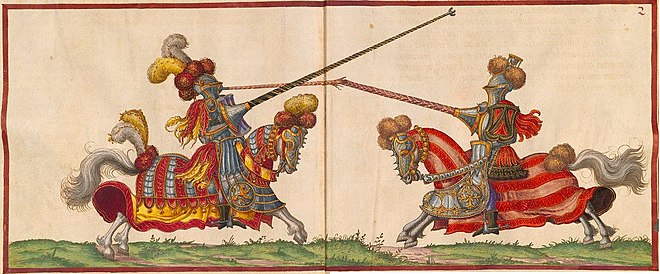
This was where the trap snapped shut on Anne Boleyn. Up until now, everything had been quite secret – this was the first public manifestation of the carnage that had been planned.
Hall’s Chronicle describes it quite simply:
On May Day were a solemn joust kept at Greenwich, and suddenly from the jousts the King departed having not above six persons with him, and came in the evening from Greenwich to his place at Westminster. Of this sudden departing many men mused, but most chiefly the Queen, who the next day was apprehended and brought from Greenwich to the Tower of London, where after she was arraigned of high treason, and condemned.
But this was when the rumors started to flow. And the stories. Now, some of you know that I have been translating a nineteenth century biography of Henry VIII – which I may or may not release because it’s just too crazy in some places – biographers back then were not held to today’s standards! This book is more like the farsical love child of Agnes Strickland and the Spanish Chronicle, and is most interesting in what it tells us of public perception (especially in France) of the goings-on at the Tudor court. The author fully agrees that Henry was an evil bully who invented charges against Anne…but does believe she had an affair with Norris (he also presents us an evil Lady Rochford who planted the suspicion in Henry’s mind). Here’s how HE describes the joust:
Each day the King felt the claws of suspicion dig deeper into his heart, and each day he found Jane Seymour more beautiful.
The envious woman [Lady Rochford] was in jubilation. However, her enemy still ruled at Whitehall. With all her heart, she wished for a disaster, without believing one might be approaching until an unforeseen circumstance precipitated it.
Festivities ended with a tournament at Greenwich. Initially, the Queen took little interest; she became attentive only when the last two combatants entered the list, visors lowered, firm in the saddle, and easily mastering their fiery steeds. One wore polished armor with a blue plume, the other dark armor with a black plume. Their names were unknown; the crowd saw only their devices, which they deposited in the hands of the field judges. That of the first was: God and King; that of the second: For her. The Queen heard someone exclaim, The insolence!
The signal was given. The two champions attacked each other with such skill that almost all the shots were parried; the ones that got through only skimmed the Milanese armor worn by the first or the Toledo steel that covered the other. Soon they heated up and performed marvels of strength, flexibility and agility. With a force so resounding that it would have been envied by the blacksmiths of Lemnos or Tilos, they dealt each other a thousand shots that joggled distant feathers on helmets, nails on cuffs, even stitches on coats of arms.
Amid these Herculean passes, the blue knight’s steel collar came detached and fell. The black knight stepped back several paces, and to restore equality to the odds, removed his own. The crowd applauded this generous act, and the fight resumed fiercer. There were two thousand breasts that dared hardly breathe … Spectators debated which one should win. Many regretted that there could not be two victors. The only sounds heard were those associated with the ardor of their effort: the clash of spears, the clatter of armor, the neighing of horses. Each of the champions clearly sought to avoid striking the other in the throat; yet it was clear that only such a blow would end the fight. The judges intervened and urged them to put their collars back on. “No,” they answered together, “we are better this way, and if you try to insist, we will remove our helmets.”
They returned to the field, and the duel began again with furor. After a moment, the black knight’s lance struck in the center of the blue knight’s chest, whose parry raised to his throat the weapon that had hit him … The injured man fell, vomiting blood, and the men-at-arms carried him off. The winner reared his horse to execute a half-turn, passed before the royal box, stopped, lifted his visor and saluted with his spear. The Queen, yielding to a moment of enthusiasm, threw her scarf to the victor, who, adorned with the trophy, withdrew amid applause.
When the Queen threw her scarf, a voice whispered: Reckless woman, what have you done? It was once again Bryan’s voice. At that moment, she felt her arm gripped by the vise of a steel gauntlet. “Go back to Whitehall,” said the King with his thunderous voice, “and stay there.”
The black knight … it was Norris!
The envious woman exulted.
From The Six Marriages of Henry VIII – Part One: The Wives; translated by Janet Wertman from Les Six Mariages de Henri VIII, by Jules d’Argis
***
If you like my posts, you’ll love my books! My Seymour Saga trilogy tells the gripping story of the short-lived dynasty that shaped the Tudor Era. Jane the Quene skews romantic, The Path to Somerset is pure Game of Thrones (without the dragons), and The Boy King is a noir coming-of-age. Get them now through Amazon, Barnes & Noble, Kobo, and Apple, or even your local independent bookstore!

(PS Already read them? Did you love them? Then please review them – even just a stars rating! It makes a huge difference in helping new readers find them and would mean the world to me!)

Be First to Comment